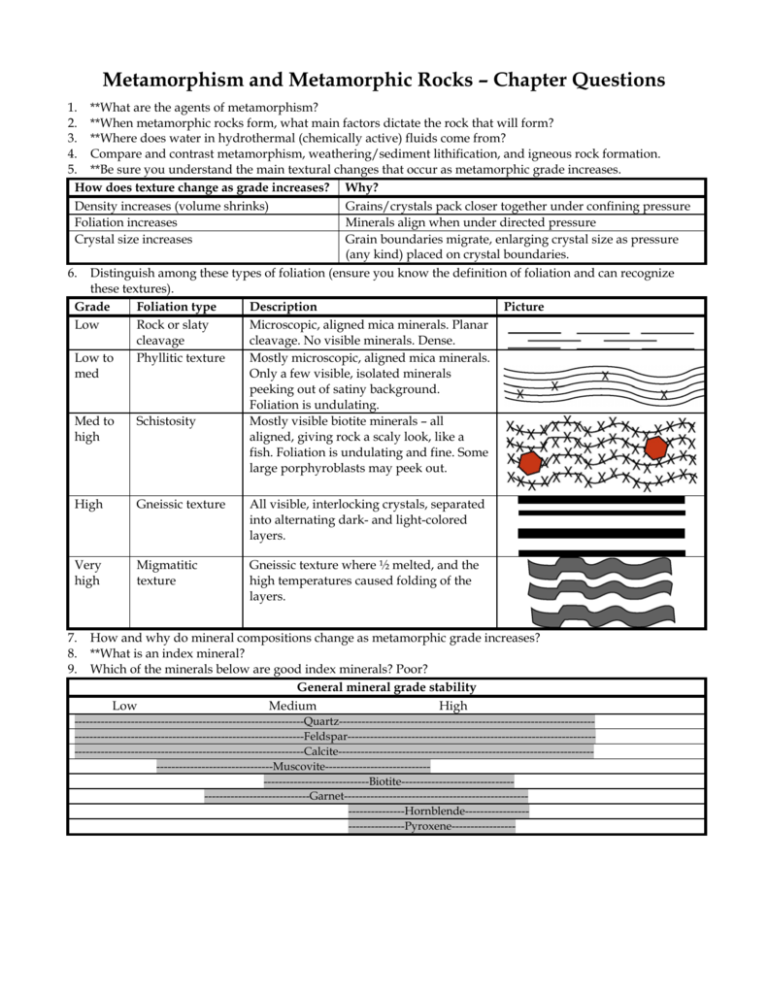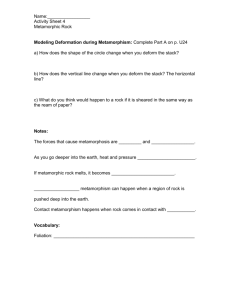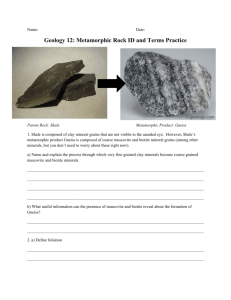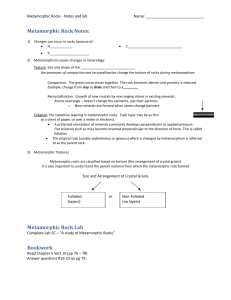Metamorphism and Metamorphic Rocks – Chapter Questions
advertisement

Metamorphism and Metamorphic Rocks – Chapter Questions 1. **What are the agents of metamorphism? 2. **When metamorphic rocks form, what main factors dictate the rock that will form? 3. **Where does water in hydrothermal (chemically active) fluids come from? 4. Compare and contrast metamorphism, weathering/sediment lithification, and igneous rock formation. 5. **Be sure you understand the main textural changes that occur as metamorphic grade increases. How does texture change as grade increases? Why? Density increases (volume shrinks) Grains/crystals pack closer together under confining pressure Foliation increases Minerals align when under directed pressure Crystal size increases Grain boundaries migrate, enlarging crystal size as pressure (any kind) placed on crystal boundaries. 6. Distinguish among these types of foliation (ensure you know the definition of foliation and can recognize these textures). Grade Foliation type Description Picture Low Rock or slaty Microscopic, aligned mica minerals. Planar cleavage cleavage. No visible minerals. Dense. Low to Phyllitic texture Mostly microscopic, aligned mica minerals. med Only a few visible, isolated minerals peeking out of satiny background. Foliation is undulating. Med to Schistosity Mostly visible biotite minerals – all high aligned, giving rock a scaly look, like a fish. Foliation is undulating and fine. Some large porphyroblasts may peek out. High Gneissic texture All visible, interlocking crystals, separated into alternating dark- and light-colored layers. Very high Migmatitic texture Gneissic texture where ½ melted, and the high temperatures caused folding of the layers. 7. 8. 9. How and why do mineral compositions change as metamorphic grade increases? **What is an index mineral? Which of the minerals below are good index minerals? Poor? General mineral grade stability Low Medium High -------------------------------------------------------------Quartz--------------------------------------------------------------------------------------------------------------------------------Feldspar------------------------------------------------------------------------------------------------------------------------------Calcite--------------------------------------------------------------------------------------------------Muscovite-------------------------------------------------------Biotite---------------------------------------------------------Garnet---------------------------------------------------------------Hornblende-------------------------------Pyroxene----------------- 10. Be sure you can describe each of the major metamorphic settings found on Earth and the P, T, and fluid conditions of each. Common metamorphic settings for metamorphism and their characteristics and symbol Metamorphic setting P T Chemically active fluids Contact metamorphism (C) Low High: increasing High – from magma and toward magma from heated surface waters Regional metamorphism: High: steadily High: steadily Low – liberated from Deep burial (B) increasing with depth increasing with depth hydrous minerals Regional metamorphism: High: increasing with Low to medium: Low – liberated from Converging continents (R) depth increasing with depth hydrous minerals Subduction zone High Low: slowly increasing High – from hydrous metamorphism (S) with depth minerals in hydrothermally altered ocean crust. Fault zones (F) Shear is high. Overall Low. None pressure is low. Hydrothermal (H) circulation Low High because occurs at High – from magmas and at spreading centers the Moho. from circulating seawater 11. **How are slate, phyllite, schist, gneiss, and migmatite formed? (Parent rock, setting, and grade) What are there similarities? Differences? 12. How are marble, quartzite, hornfels, and skarn formed? (Parent rock, setting, and grade) What are there similarities? Differences? 13. How are greenstone and eclogite formed? (Parent rock, setting, and grade) What are there similarities? Differences? 14. **How is serpentinite formed? (Parent rock, setting, and grade) 15. The chart below summarizes the parent rock, setting, and grade of common metamorphic rocks. Be sure you understand all of the rock’s origins. Metamorphic rock names based on parent rock, geologic setting, and metamorphic grade. Metamorphic settings B, R, S B, R, S S B, R, S B, R, S Parent rock Shale Granite Basalt Chert (SiO2) Limestone (CaCO3) Quartzite (crystals Marble (crystals GRADE: Slate Greenstone grow larger) grow larger) Low Phyllite Blueschist Low - Med Schist Eclogite Med - High Gneiss Gneiss High Migmatite Migmatite Very High Metamorphic settings Parent rock C Chert (SiO2) GRADE: Low Low - Med Med - High High Very High Quartzite (crystals grow larger) C Limestone (CaCO3) Marble (crystals grow larger) C Mixture of minerals Skarn (crystals grow larger; form new minerals) C Shale C Basalt H Mantle rock (Peridotite) Hornfels Hornfels Serpentinite








